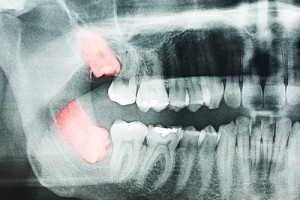Modern Choices For Wisdom Teeth Management
 The third row of molars at the back of your mouth – also called wisdom teeth – usually develop between ages 16 and 23. It’s important for teens and young adults to be involved in the decision on how to treat their wisdom teeth. You might opt for early removal or the wait-and-see approach based on your unique situation.
The third row of molars at the back of your mouth – also called wisdom teeth – usually develop between ages 16 and 23. It’s important for teens and young adults to be involved in the decision on how to treat their wisdom teeth. You might opt for early removal or the wait-and-see approach based on your unique situation.
When Early Removal is Necessary
It’s wise to take quick action and seek removal sooner rather than later if:
- Your wisdom teeth become impacted, meaning they never emerge from the gums and remain trapped within your jaw. This can affect the roots of the adjacent teeth and cause pain.
- Your wisdom teeth partially erupt through the gums, causing inflammation and pain. Partial eruption also creates a passageway under the gums that bacteria can get inside. This can lead to gum disease and oral infection.
- Your wisdom teeth erupt at an angle. Sometimes an angular eruption butts up against the adjacent tooth, making it difficult to clean. The wisdom tooth’s position may also cause the gums to recede around the adjacent tooth. If so, the wisdom tooth should be removed before too much damage is done around the more critical second molar.
- Your wisdom teeth develop an infection. Soft gum tissue can grow over a partially erupted wisdom tooth, trapping bacteria inside and causing an infection called pericoronitis. This is most likely to occur when there’s not enough room for wisdom teeth in the lower jaw. Symptoms of this infection include inflamed gums, bad taste or smell in the mouth, pain when biting down, and pus draining from the site. These symptoms indicate the need for emergency extraction.
Whether you can see your wisdom teeth developing or not, it may be wise to have them removed before the roots are fully formed. It’s easier for a young person with wisdom teeth not yet rooted in the jaw to recover from surgery.
When it’s Acceptable to Wait and See
Once you hit age 16, you should ask Dr. Evanson to take periodic x-rays, also know as radiographs, to start tracking the changes at the back of your mouth. It’s acceptable to take the wait-and-see approach if:
- Your wisdom teeth have fully erupted, meaning the wisdom teeth have grown in completely.
- Your wisdom teeth are healthy and don’t compromise the adjacent teeth.
- Your wisdom teeth are positioned correctly and those in the upper jaw make proper contact with those in the lower jaw for a healthy bite.
- Your wisdom teeth remain easy to clean as you perform your daily oral hygiene practices.
- Your wisdom teeth never develop. Most people have wisdom teeth, but it’s possible that some or all four of your third-row molars might never develop.
It’s important to note that in many cases, wisdom teeth are not visible because they never erupt through the gums. That’s why periodic radiographs are important to keep an eye on possible impacted wisdom teeth.
What to Do If You Retain Your Wisdom Teeth
After keeping a close eye on your erupting wisdom teeth, you may decide not to have them removed. If so, make sure you take particular care to brush as far back in your mouth as possible. Floss behind your third molars as well to help keep bacteria at bay. You’ll also need to have your teeth professionally examined, x-rayed and cleaned at least once a year to make sure your teeth and gums don’t change.
The decision to have your wisdom teeth removed is often not clear cut. If you have any concerns, stop in and talk with Dr. Evanson. We can help you make the best decision for your situation. Please contact Evanson DDS online or call us at (720) 409-0008 to schedule a wisdom tooth consultation.
Leave a reply →





